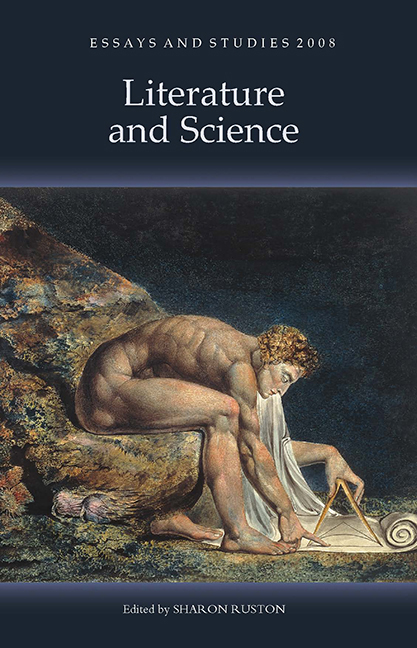Book contents
- Frontmatter
- Contents
- List of Illustrations
- Acknowledgements
- Notes on Contributors
- Introduction
- 1 From Popular Science To Contemplation: The Clouds Of The Cloud Of Unknowing
- 2 ‘Dreams And Plain Dotage’: The Value Of The Birth Of Mankind (1540–1654)
- 3 Natural Rights And Natural History In Anna Barbauld And Mary Wollstonecraft
- 4 George Eliot, Geometry And Gender
- 5 On The Back Of The Light Waves: Novel Possibilities In The ‘Fourth Dimension’
- 6 Le Fanu's ‘Carmilla’, Ireland, And Diseased Vision
- 7 Evolution, Literary History And Science Fiction
- 8 ‘The Luxury Of Storytelling’: Science, Literature And Cultural Contest In Ian Mcewan's Narrative Practice
- Index
5 - On The Back Of The Light Waves: Novel Possibilities In The ‘Fourth Dimension’
Published online by Cambridge University Press: 12 February 2019
- Frontmatter
- Contents
- List of Illustrations
- Acknowledgements
- Notes on Contributors
- Introduction
- 1 From Popular Science To Contemplation: The Clouds Of The Cloud Of Unknowing
- 2 ‘Dreams And Plain Dotage’: The Value Of The Birth Of Mankind (1540–1654)
- 3 Natural Rights And Natural History In Anna Barbauld And Mary Wollstonecraft
- 4 George Eliot, Geometry And Gender
- 5 On The Back Of The Light Waves: Novel Possibilities In The ‘Fourth Dimension’
- 6 Le Fanu's ‘Carmilla’, Ireland, And Diseased Vision
- 7 Evolution, Literary History And Science Fiction
- 8 ‘The Luxury Of Storytelling’: Science, Literature And Cultural Contest In Ian Mcewan's Narrative Practice
- Index
Summary
‘The fourth dimension's out of joint. Oh spite That ever I was born to set it right!’
(Punch, 1919a, 442)
IN 1934 Dorothy L. Sayers paid tribute to a popular science author whom she admired very much, when she had Lord Peter Wimsey travel ‘[o]n the back of the light waves’ in solving a murder case (Sayers 1934b, 195). Her short story ‘Absolutely Elsewhere’ was published in Strand Magazine in February, having appeared across the Atlantic the previous month under the title ‘Impossible Alibi’ in Mystery, the Illustrated Detective Magazine. ‘Absolutely Elsewhere’ was subsequently broadcast by the BBC in 1940. By 1934 the trajectory of Wimsey's character development (commenced in 1920) was approaching completion and the aristocratic detective was well-known among readers of Sayers’ novels; the best-seller Five Red Herrings, also published at the start of 1934, assured her celebrity status. At the beginning of ‘Absolutely Elsewhere’ Chief Inspector Parker explains that ‘all the obvious suspects were elsewhere at the time’ (1934a, 185). Wimsey's response comes directly from Arthur Stanley Eddington's bestselling exposition of Einstein's relativity:
‘What do you mean by “elsewhere”?’ demanded Wimsey, peevishly. Parker had hauled him down to Wapley, on the Great North Road, without his breakfast, and his temper had suffered. ‘Do you mean that they couldn't have reached the scene of the murder without travelling at over 186,000 miles a second? Because, if you don't mean that, they weren't absolutely elsewhere. They were only relatively and apparently elsewhere.’
‘For heaven's sake, don't go all Eddington. Humanly speaking, they were elsewhere, and if we're going to nail one of them we shall have to do it without going into their Fitzgerald contractions and coefficients of spherical curvature.’
Sayers’ British readers would have empathized with Parker's plea for common sense to prevail over the technicalities of Einsteinian time and space. Those who had not looked at The Nature of the Physical World (1928) could scarcely have avoided all reference to this exposition, in magazines or on the radio.2 By 1934 Eddington's name had been publicly associated with that of Einstein for fifteen years, following his appearance as Einstein's champion when relativity made headline news in November 1919.
- Type
- Chapter
- Information
- Literature and Science , pp. 91 - 110Publisher: Boydell & BrewerPrint publication year: 2008



